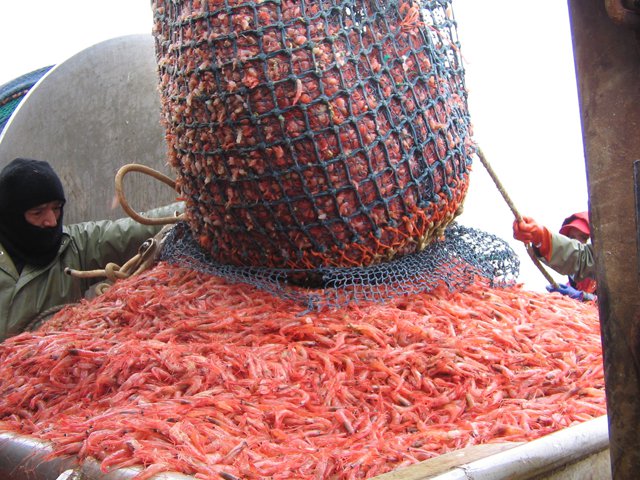If this winter is anything like the last, it could be difficult — not to mention expensive — to get your hands on cold-water-loving northern Maine shrimp. For the fourth consecutive year, regulators have extended a moratorium on the commercial season for northern shrimp (Pandalus borealis, often sold under the market name Maine shrimp) in hopes that stocks rebound.
Despite the moratorium on Maine shrimp, regulators are allowing almost 117,000 pounds to be landed as part of sampling research. NOAA photo.In 2011, fishermen from Maine, New Hampshire and Massachusetts hauled in more than 10 million pounds of shrimp, worth $7,627,447.
Despite the moratorium, it is possible that some consumers or restaurateurs can score some of the delicate pink shrimp this year, because regulators are allowing almost 117,000 pounds of the research sampling to be landed. The eight trawlers and five trappers participating in the program are permitted to sell their shrimp catch.
Each trawler will be required to collect samples each week in one of three regions being tested, and will be allowed to land and sell up to 1,200 pounds of shrimp per trip. They will be allowed to operate beginning in mid- to late January for eight weeks, fishing once a week.
Trappers (traditionally lobstermen) will collect shrimp samples in two regions of the Maine coast beginning Jan. 30, 2017, once a week, for eight weeks until March 26. Each trapper will be allowed to fish up to 40 traps, hauled as often as necessary during the project. Participants will be allowed to land and sell up to 500 pounds of shrimp per week.
There is no additional compensation for participating in the sampling program in addition to selling their catch.
A technical committee recommended extending the moratorium through 2017 to “continue conservation gains from the current moratorium,” according to Max Appelman, Fishery Management Plan coordinator for the Atlantic States Marine Fisheries Commission. “The 2016 stock status report indicates the 2012-2016 indices of harvestable biomass are the lowest on record.”
Appelman and Maggie Hunter, a biologist in Maine’s Department of Marine Resources Northern Shrimp Program, agree that ocean temperature influences this shrimp’s behavior. Cool temperatures during winter and late summer of the first year of life help shrimp survive.
“Overall, ocean temperatures have not been favorable for northern shrimp in the Gulf of Maine since around 2000, and long-term trends indicate that temperatures will continue to increase in the GOM,” adds Appleman. Predation on shrimp by fish has also increased, says Hunter, as species like squid could also be experiencing northward shifts in their distributions as waters warm.







